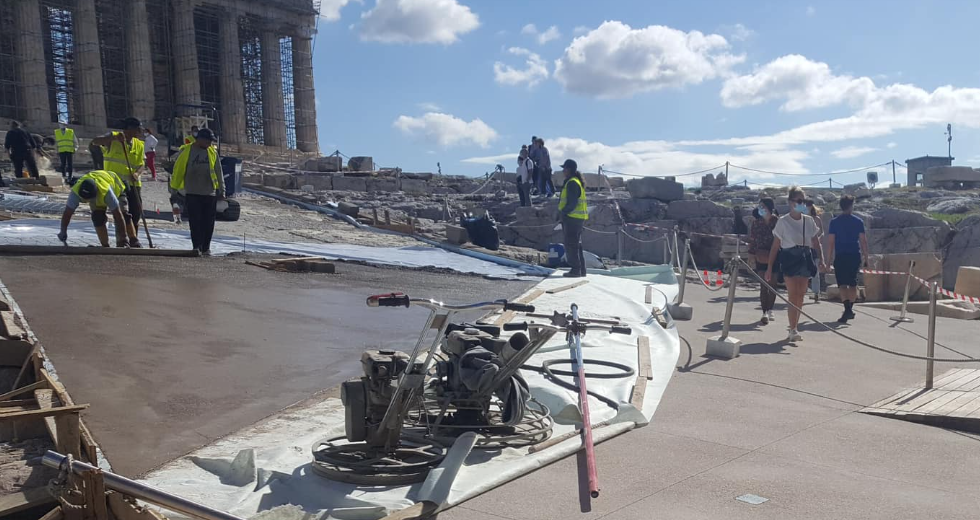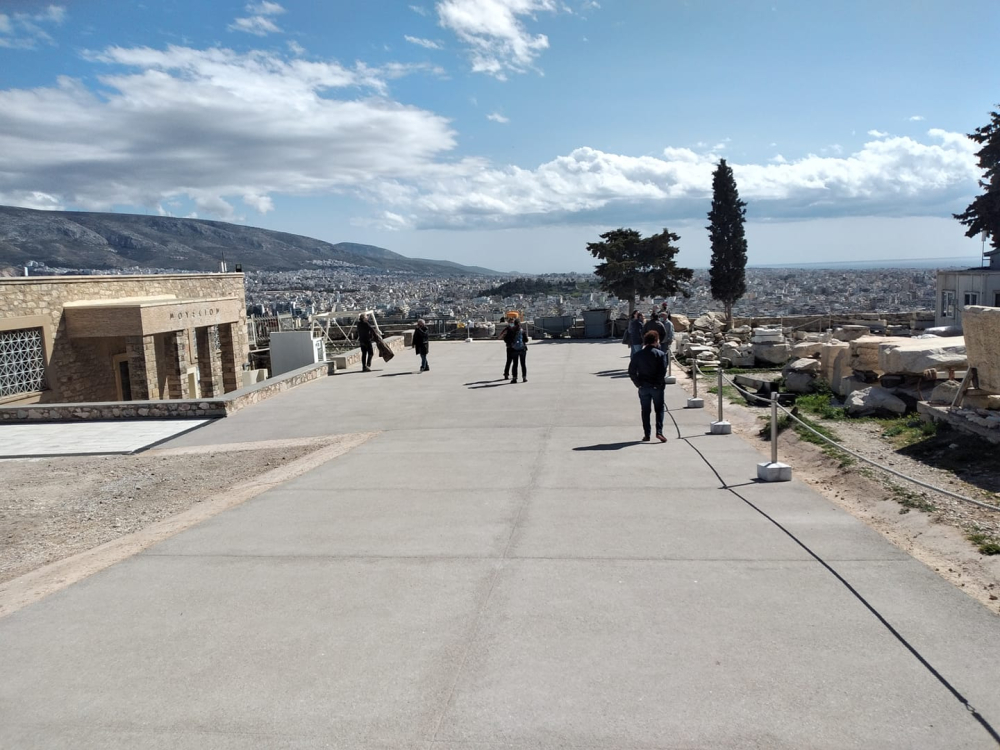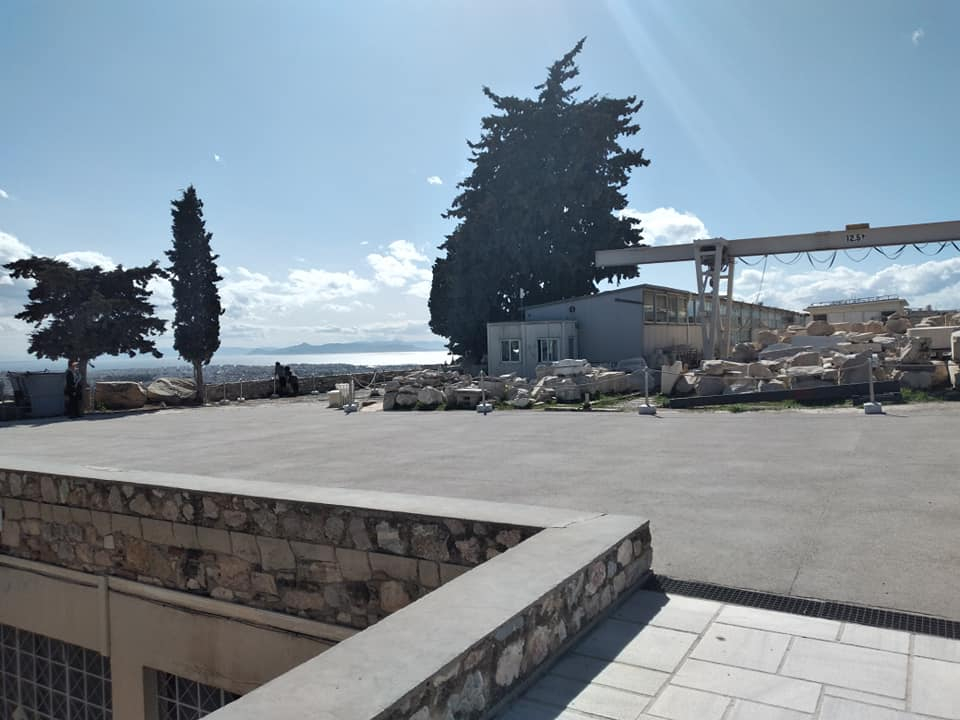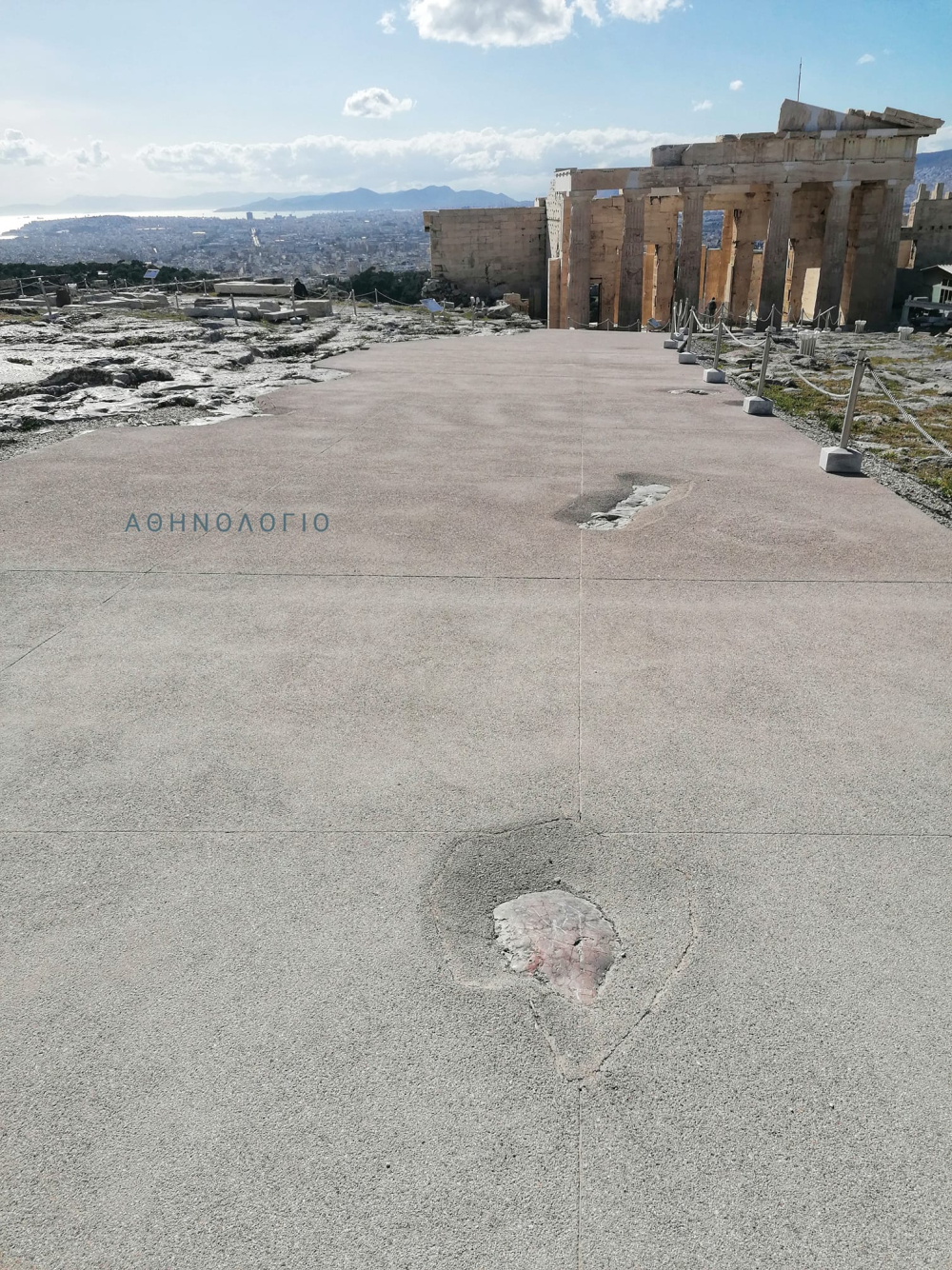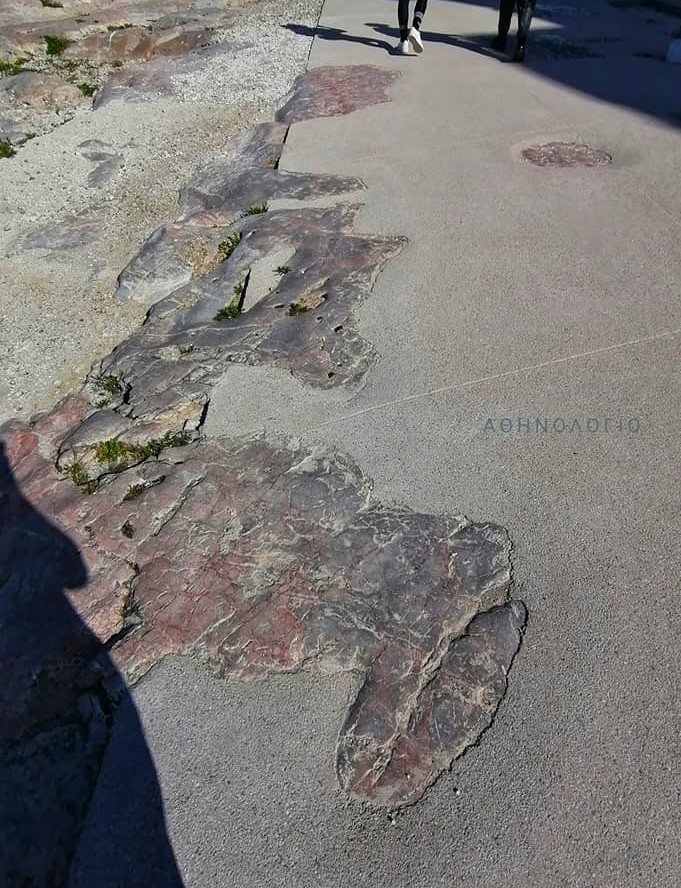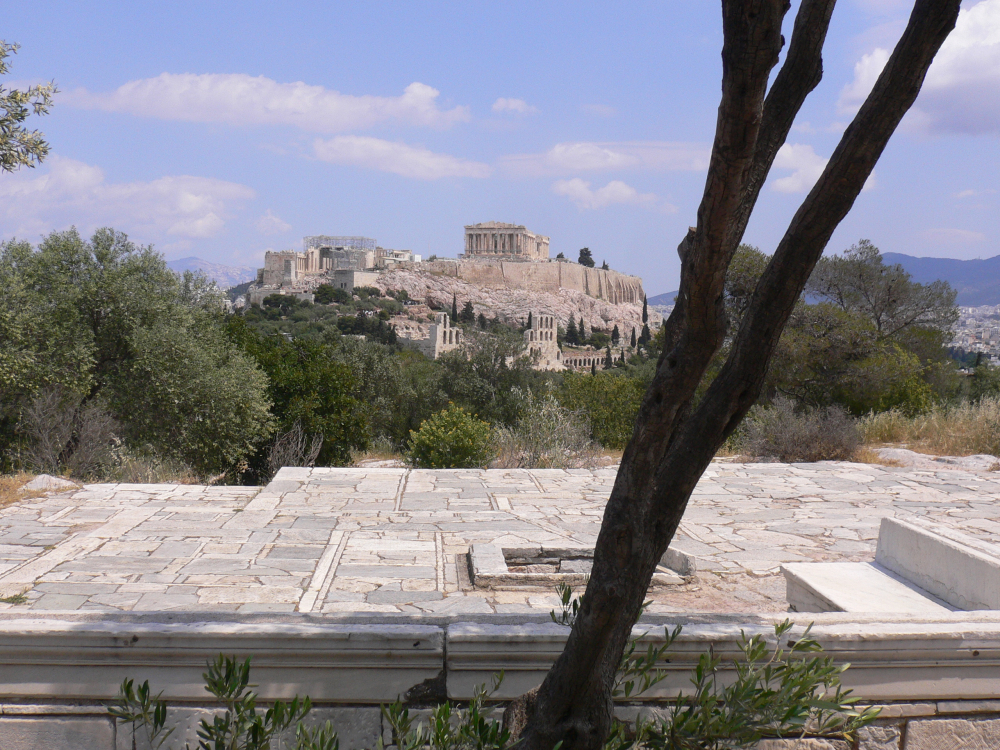Since late 2020, alarming changes have taken place on the Acropolis Rock, altering both its appearance and ambience. The most emblematic archaeological site in Greece is being attacked by huge quantities of reinforced concrete and more dramatic changes are expected to have occurred by summer 2021.
The main players are: Antonis Papadimitriou, the powerful President of the Onassis Foundation which is financing the «upgrading of the infrastructure» on the Acropolis rock as «part of a larger strategy» concerning the profile of Athens, Professor Manolis Korres, an architect member of the Academy of Athens, former head of the Parthenon Restoration Project until 1998, who is providing scientific cover, and Lina Mendoni, the Minister of Culture of the Mitsotakis government, who is participating tacitly.
The completed intervention on the Acropolis has been carried out in successive stages by private technical companies chosen by the Onassis Foundation. It proceeded smoothly and rapidly, having sidestepped the institutional framework required by law and the Constitution for any work on the monuments of antiquity, especially on the Acropolis (UNESCO World Heritage Site, 1987). At the same time the Ministry tried hard to succeed in fast tracking the process for securing the necessary approvals for its institutional legitimacy retroactively.
Thus, today, although the visitors’ initiatory route to the Parthenon has been permanently disfigured by a reinforced concrete avenue made for tourists, everything was supposedly done by the book. And this is how it was presented by the Minister of Culture to the Hellenic Parliament in mid-April, as she responded (with no little irony) to the protests of the Opposition.
Nevertheless, an unprecedented mobilization of Greece’s cultural forces, along with international experts, continues to swell against this violation of the Acropolis currently under way. Although the Minister is targeting the Left, the wave of protest actually united from the very beginning the most renowned archaeologists, historians, intellectuals, architects, art historians, Hellenists, etc., of every political affiliation except for the far right, many of whom have signed a petition to collect protest signatures from experts. From the beginning of March until today dozens of signatures from Greek and international scientists who carry significant weight have been collected. The ultimate purpose of all the signatories to the “Plea against the Interventions on the Acropolis” is to ask for “the establishment of institutional procedures that will allow for the exchange of views and discussions leading to a consensus, to prevent future incidents where influential individuals can unilaterally impose permanent alterations to the Acropolis”.
What do these protestors “see”? They “see” that the interventions will abolish the wise balance that existed since antiquity on the rock of the Acropolis between the natural landscape and the architectural masses of the buildings (Parthenon, Erechtheum, Propylaea, Temple of Athena Nike) and will alter the wholeness of the centuries-old cultural landscape. The surface area of the Acropolis rock is approximately 27 acres and the buildings occupy 1/3 of this surface. The rest was left bare. With the new constructions, practically the entire expanse of the monument will be covered by reinforced concrete, i.e., much more than an additional 1/3 of the surface area of the rock.
The plan is to construct horizontal surfaces (terraces) for tourists at different levels that will “contribute to the proper appreciation” of the monument. The plan also includes wide marble steps leading to the Propylaea from the west, since Korres promised to “reconstruct the Roman flight of stairs” as it existed during the 1st c. AD at the western access to the Acropolis. The so-called “restoration of the Panathenaic Way” has already been implemented. Thus, the processional route of the ancient feast celebrating the goddess Athena[1] will be used to move crowds of tourists. This is the stated purpose of the interventions as described in the press releases of the Ministry of Culture. The harshest critics of this imperious plan also point out what is not described: The natural landscape and the rock are being devalued as a natural monument, there is no rainwater management, the new construction will cover or destroy the native rock as well as valuable archaeological evidence of various periods, traces of monument foundations, etc., which will become inaccessible forever.
It was Tasos Tanoulas, the architect who has been in charge of the Propylaea Restoration Project for more than three decades, who first published information and scientific criticism concerning the extensive paving project on the Acropolis as well as Korres’ statements. He pointed out that earlier intervention achieved aesthetic integration with the surrounding rock surface, allowing the natural rock, the major monuments and the remains of the lesser ones to be perceived as a whole. The materials – aggregates, lime mortar and cement – the absence of metal reinforcement, and the procedure of application on the rock, guaranteed reversablity – the possibility of complete removal without problems – and permeability. He also suggested that the flow of tourists should be distributed during the whole length of the opening hours of the site.
And only then, only last November 2020, came the first official explanation given by the Ministry of Culture saying that the intervention was necessary to facilitate access for people with disabilities. A later explanation referred to the need to manage large volumes of visitors, since in 2018 there were 3,150,604 visitors, while in 2019 there was a total of 3,593,586 visitors on the Acropolis.
Maneuvers
In December 2020, the construction of the slope elevator for individuals with mobility issues was already completed by external contractors (this replaced the platform lift installed in 2004). While earlier, in September 2020, the new, spectacular and much-advertised lighting of the rock of the Acropolis was celebrated in the presence of the President of the Republic Katerina Sakellaropoulou and Prime Minister Kyriakos Mitsotakis. Both projects were implemented through a 1.7 million euro donation from the Onassis Foundation.
Subsequently, as negative criticism spread, regarding the problems caused by the concrete that was being laid, Manolis Korres in his capacity as President of the Committee for the Preservation of the Acropolis Monuments (ESMA) defended the first phase of the reinforced concrete paving as the prelude to a larger intervention, which, however, had never been officially announced by the Minister of Culture until then. Almost three months later, on February 2, 2021, the ESMA submitted its proposal for an equally large intervention _consisting of the leveling of the Acropolis plateau in several terraces _ to the Central Archaeological Council (KAS), the highest advisory body on archaeological issues, whose members are appointed by the Minister of Culture, and include Korres. The proposal was adopted unanimously, although no associated study had been submitted, and the KAS always delivers opinions based on specific studies.
The cycle of imperious interventions on the Acropolis continued uninterruptedly from February 28, 2020, when the 1,7 m. euro donation agreement was signed between the Greek State and the Onassis Public Benefit Foundation as donor, with Ariona Hellas S.A. as the implementing body. Two modifications followed, involving the addition of a second implementing body, NAMA Consulting Engineers and Planners S.A. In mid-April 2021, when the Minister of Culture first had to account for all these maneuvers in Parliament (in the context of parliamentary scrutiny), Mendoni, an archaeologist, argued that everything was done “in accordance with Law 4182/2013”.
How to use the symbolic capital
Everything could have turned out differently had the principal actors involved in this affair evidenced different sensitivities and a different sense of duty. Instead, they simply joined forces in an effort to make political and ideological use of the symbolic capital of the Acropolis. In a time of multifaceted crisis and uncontested failure to manage the pandemic, the political leadership is employing the cultural heritage of antiquity to promote itself both domestically and internationally. The message it conveys expresses its policy choices, linking the country’s national prestige to private initiative and reorienting the meaning of social policy towards the realm of charity. For its part, the shipping giant is revamping and enhancing its social profile as well as its visibility by associating its entrepreneurial spirit with the splendor of one of the leading symbols of both the world history of Civilization and Democracy. It is no coincidence that the donation contract provides for the placement of a plaque with the sponsor’s name on the Acropolis.
Naturally, this is not the first time that the Ministry of Culture has partnered with the private sector. On the contrary, in a country plagued by a decade-long financial and humanitarian crisis, such a partnership is apparently an almost essential condition for some projects to move forward in the field of culture, which, for half a century has received very miserly funding from the central government budget. It is a fact that, since 2008, when there began a period of severe social unrest, public benefit foundations or private charitable organizations, associated with powerful business groups that secured favorable terms or trade-offs from the State, either took the initiative to make large donations or partner with government agencies, or independently proceeded to invest business profits in programs aiming to stimulate cultural life. Up until now, however, their activities mainly embraced the production of contemporary culture and artistic resources. One typical example is the cultural center, which includes the National Library and the National Opera that the Stavros Niarchos Foundation donated to the Greek state in 2018. Instead, the Minister of Culture Lina Mendoni spoke about an “upgrade of the image of the Acropolis”. And Korres promises to restore the “monumentality” and “authenticity” of the ascent to the Propylaea, a proposal which Mendoni was swift to embrace. But what do these words actually mean?
Up until now, Modern Greece’s cultural heritage was thought to be the responsibility of the State, as a strong element of the national identity, connected with the creation of the neo-Hellenic nation[2]. The forceful entrance of the Onassis Foundation into this field denotes a new approach regarding the management and possible reorientation of Greece’s cultural and symbolic capital (as Pierre Bourdieu has put it). This raises very serious concerns precisely because these interventions are proceeding with an arbitrary momentum, because they lack any prior experience and scientific dialogue discussing different approaches, and because they have controversial ideological parameters. But most importantly, there is no specific legal framework to welcome similar initiatives of the private sector and, at the same time, to safeguard the public character of culture and underline the State’s duty to serve the public good.
A walk on the Filoppapou hill opposite the Acropolis is enlightening. The Greek architect Dimitris Pikionis belonged in the movement of Greek intellectuals and artists who, in the 20th century, tried to integrate Greek tradition into modernism. In the 1950s he redesigned the footpaths on the Philopappos hill and the ones leading to the entrance of the Acropolis, creating an extensive landscape art installation, before this term was coined in the international art world. His pathways, with recycled and newly cut stone and marble slabs, are so ingeniously fitted into the natural surroundings that one cannot really tell if these parts were newly built or if they had been there since ever. Travlos, on the Acropolis, used no stone, avoiding any competition with the monuments nearby. No such subtleties can be recognized in the recent cementation on the Acropolis rock.
[1] The Panathenaea, the most important feast in Athens, honored the goddess Athena. The Greater Panathenaea, which were splendidly celebrated every four years, lasted twelve days and included ceremonies, competitions, dances, etc. On the final day, everyone would participate in the grand procession that, beginning at Kerameikos and ending on the Acropolis, carried the sacred peplos (robe) to the xoanon (ancient wooden statue) of Athena Polias along with other offerings to the goddess.
[2] Greece emerged as a modern nation state in 1830 following a War of Independence (1821-1827) against the Ottoman Empire. The Ottoman dominion had started in the southern part of the Balkans in the mid 15th century
COMMENT
Grief, Anger, Struggle
What was done on the sacred rock of the Acropolis both disturbed the authenticity of the antiquities and caused damages, while it remains unclear whether this can be reversed.
Whereas the ostensible purpose of the new walkways—large-scale platforms constructed of reinforced concrete—is to facilitate access for the disabled, they will primarily serve the hordes of tourists, seemingly without any planning and management strategies for the tourists or the monument itself. Additionally, and this is distressing and dangerous, concrete terraces have been planned to supposedly restore the original ground levels of antiquity in the Acropolis plateau, while to the west of the Propylaea a monumental stairway of the 1stc. A.D. will be constructed. The completed pavements are supposed to represent only the Panathenaic Way.
How can such interventions take place before any research is compiled? Precisely what is the position of Greece or better yet of the Greek government with regard to humanity’s iconic monument, which holds pride of place on UNESCO’s World Heritage Sites List? Does it allow the implementation of the views of authorities that have not been submitted to the Greek and international scientific community and to approval processes? Does it carry out the desires of private non profit foundations that wish to transform monuments as if there were no tomorrow. Can one possibly put a price on the symbolic capital of a monument such as the Acropolis? Who has the right to modify its appearance, to wound its monuments, to wipe out the traces of its centuries-old life and the evidence of its use?
There causes grief, anger, but also the struggle and desire to protect the monument from arrogance.
Maria Terzoude, archaeologist, one of the many experts who signed the Petition
Photos: Tasos Tanoulas, architect, restorer, architectural historian. He worked from 1976-2010 for the Hellenic Ministry of Culture on the restoration of classical monuments and was the architect in charge of the Propylaea Restoration Project.

